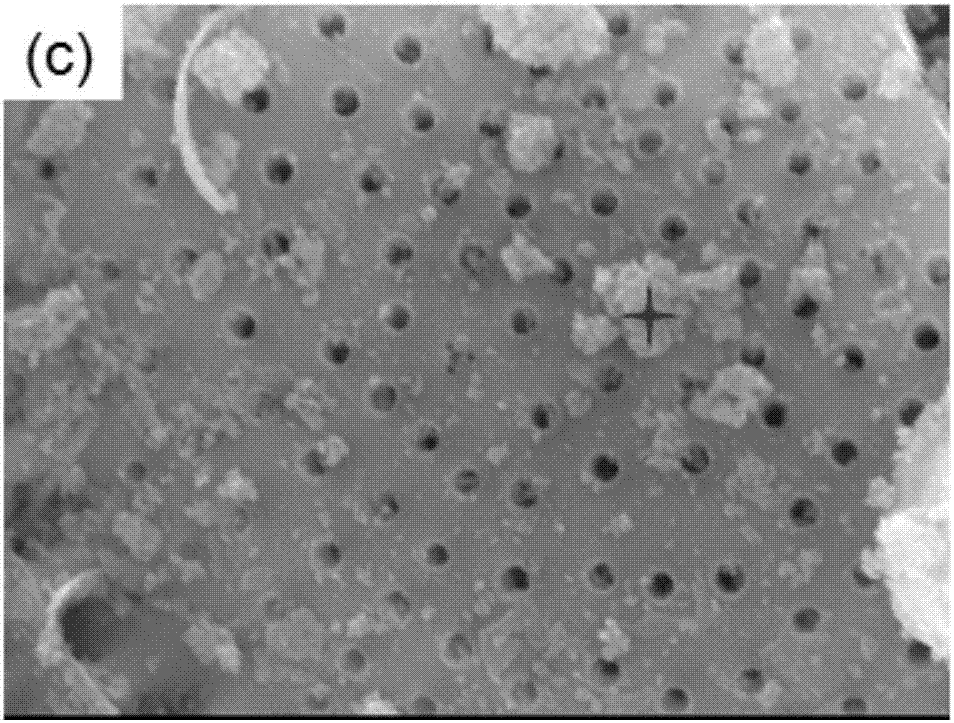Preparation method of diatomite/(GR+TiO2) composite photocatalyst
A technology of diatomite and composite light, which is applied in the direction of physical/chemical process catalysts, chemical instruments and methods, and other chemical processes. The effect of improving adsorption efficiency
- Summary
- Abstract
- Description
- Claims
- Application Information
AI Technical Summary
Problems solved by technology
Method used
Image
Examples
Embodiment 1
[0029] Select raw materials according to the following requirements:
[0030] 1) Diatomite: finely purified diatomite, fineness 80 mesh, silicon dioxide content 80%;
[0031] 2) tetrabutyl titanate: technically pure;
[0032] 3) Graphene: graphene oxide;
[0033] 4) absolute ethanol: industrial pure;
[0034] 5) Acetic acid: industrial grade.
[0035] The method comprises the steps of:
[0036] 1) Measure 15mL of tetrabutyl titanate, 75mL of absolute ethanol, 7.5mL of distilled water and 1.5mL of acetic acid. TiO 2 Precursor gel, set aside;
[0037] 2) Weigh 30g of purified diatomite powder, 0.8g of graphene, and weigh TiO 2 Precursor gel, converted into 8g of titanium dioxide, add appropriate amount of water to stir and mix the three, put it in a high-pressure reactor, and react at 150°C for 12 hours under magnetic stirring;
[0038] 3) After drying the mixed solution at 60°C, place it in a nitrogen atmosphere furnace, and keep it at 650°C for 2 hours to obtain diatom...
Embodiment 2
[0041] Select raw materials according to the following requirements:
[0042] 1) Diatomite: finely purified diatomite with a fineness of 800 mesh and a silicon dioxide content of 86%;
[0043] 2) tetrabutyl titanate: technically pure;
[0044] 3) Graphene: graphene oxide;
[0045] 4) absolute ethanol: industrial pure;
[0046] 5) Acetic acid: industrial grade.
[0047] The method comprises the steps of:
[0048] 1) Measure 5mL of tetrabutyl titanate, 65mL of absolute ethanol, 6mL of distilled water and 1mL of acetic acid. 2 Precursor gel, set aside;
[0049] 2) Weigh 85g of purified diatomite powder, 1.5g of graphene, and weigh TiO 2 Precursor gel, converted into 5g of titanium dioxide, add appropriate amount of water to stir and mix the three, put it in a high-pressure reactor, and react at 20°C for 1 hour under magnetic stirring;
[0050] 3) After drying the mixed solution at 80°C, place it in a nitrogen atmosphere furnace, and keep it at 300°C for 1 hour to obtain di...
Embodiment 3
[0052] Select raw materials according to the following requirements:
[0053]1) Diatomite: Finely purified diatomite with a fineness of 1250 mesh and a silicon dioxide content of 92%;
[0054] 2) tetrabutyl titanate: technically pure;
[0055] 3) Graphene: graphene oxide;
[0056] 4) absolute ethanol: industrial pure;
[0057] 5) Acetic acid: industrial grade.
[0058] The method comprises the steps of:
[0059] 1) Measure 10mL of tetrabutyl titanate, 70mL of absolute ethanol, 10mL of distilled water and 5mL of acetic acid. 2 Precursor gel, set aside;
[0060] 2) Weigh 95g of purified diatomite powder, 2.5g of graphene, and weigh TiO 2 Precursor gel, converted into 2.5g of titanium dioxide, add appropriate amount of water to stir and mix the three, put it in a high-pressure reactor, and react at 200°C for 30h under magnetic stirring;
[0061] 3) After the mixed solution was dried at 70°C, it was placed in a nitrogen atmosphere furnace, and kept at 800°C for 100 hours to...
PUM
 Login to View More
Login to View More Abstract
Description
Claims
Application Information
 Login to View More
Login to View More - R&D
- Intellectual Property
- Life Sciences
- Materials
- Tech Scout
- Unparalleled Data Quality
- Higher Quality Content
- 60% Fewer Hallucinations
Browse by: Latest US Patents, China's latest patents, Technical Efficacy Thesaurus, Application Domain, Technology Topic, Popular Technical Reports.
© 2025 PatSnap. All rights reserved.Legal|Privacy policy|Modern Slavery Act Transparency Statement|Sitemap|About US| Contact US: help@patsnap.com


